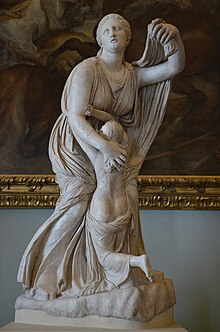Niobe (mythology)



Niobe ( ancient Greek Νιόβη Nióbē ) is in Greek mythology the daughter of Tantalus and Dione or Euryanassa and the sister of Pelops and Broteas . It too was subject to the tantalid curse .
Niobe's fate
The legend
Niobe gave birth to seven sons and seven daughters as the wife of the Theban king Amphion . Proud of her numerous offspring , she presumed to place herself above the Titane Leto , who had only given birth to two children, Apollon and Artemis , and prevented the people from worshiping them.
The offended Titan turned to her children. Thereupon, in one day, Apollo and Artemis struck down first all their sons and then all their daughters with a bow and arrow. Niobe asked the twins to let her have the youngest daughter, but she collapsed dead. The parents could not survive this misery: Amphion killed himself with a sword, and Niobe froze from the immense pain of the loss. Then she was moved by a wind to Phrygia on the top of Mount Sipylos . But even the stone did not stop shedding tears.
The myth is told by Ovid in his Metamorphoses (6,146-312). The seven sons of Niobe are named Ismenus, Sipylus, Phaedimus, Tantalus, Alphenor, Damasichthon and Ilioneus, while the names of the seven daughters are not mentioned.
interpretation
Niobe is sometimes interpreted as a special form of a vegetation or earth goddess, whose offspring are stretched out by the scorching arrows of the sun god.
As a subject in poetry, music and the visual arts
The highly tragic subject was dealt with many times by the masters of both dramatic and visual arts. Only fragments remain of the tragedies of Aeschylus and Sophocles .
This material can also be found in opera literature:
- Adriana Hölszky (born 1953): Hybris / Niobe , drama for voices by Yona Kim. First performance in 2008 in the Rococo theater of the Schwetzingen Palace
- Agostino Steffani (1654–1728): Niobe, regina di Tebe , Dramma per musica in three acts by Luigi Orlandi

A group of Niobe and their children has survived from Roman times (excavated in 1583, now in the Uffizi Gallery in Florence , see illustration). It is a replica of a work of Hellenistic sculpture. Of the Greek original, which Pliny the Elder saw in the temple of Apollo Sosianus in Rome, in the 1st century AD it was no longer possible to say whether Praxiteles or Skopas was the author. The center of the group is the figure of Niobe herself with the daughter who has fallen at her feet and hides her head in her mother's lap. Her children flee from both sides, partly already hit, partly looking around in horror for the whirring death bullets to the mother. The single copy of a daughter from the group, now in the Vatican , gives the best idea of the beauty of the original.
Individual reliefs and murals repeat the same object; Terracotta figures of fleeing niobids have been found in the Crimea .
Namesake in science
The element niobium and the asteroid (71) Niobe are named after Niobe .
See also
literature
in alphabetical order by authors / editors
- Alexander Enmann , Bruno Sauer : Niobe and the Niobids . In: Wilhelm Heinrich Roscher (Hrsg.): Detailed lexicon of Greek and Roman mythology . Volume 3.1, Leipzig 1902, Col. 372-423 ( digitized version ).
- Wilfred Geominy : The Florentine Niobids. Dissertation, University of Bonn 1984.
- Karl Kerényi : Apollon and Niobe. Langen Müller, Munich 1980, ISBN 3-7844-1756-6 .
- Angela Oster: Niobe. In: Maria Moog-Grünewald (Ed.): Mythenrezeption. The ancient mythology in literature, music and art from the beginnings to the present (= Der Neue Pauly . Supplements. Volume 5). Metzler, Stuttgart / Weimar 2008, ISBN 978-3-476-02032-1 , pp. 469-473.
- Elsbeth Wiemann: The Myth of Niobe and Her Children. Studies on representation and reception (= manuscripts for art history in the Werner publishing company 8). At the same time dissertation at the University of Würzburg 1982. Wernersche Verlagsgesellschaft, Worms 1986, ISBN 3-88462-907-7